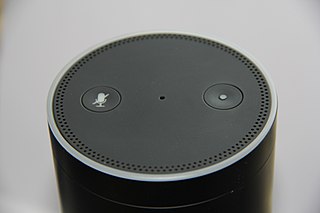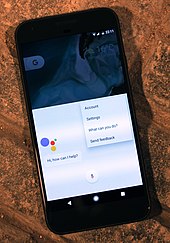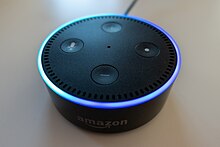
A chatbot is a software application or web interface that is designed to mimic human conversation through text or voice interactions. Modern chatbots are typically online and use generative artificial intelligence systems that are capable of maintaining a conversation with a user in natural language and simulating the way a human would behave as a conversational partner. Such chatbots often use deep learning and natural language processing, but simpler chatbots have existed for decades.
A voice-user interface (VUI) enables spoken human interaction with computers, using speech recognition to understand spoken commands and answer questions, and typically text to speech to play a reply. A voice command device is a device controlled with a voice user interface.
In artificial intelligence, an embodied agent, also sometimes referred to as an interface agent, is an intelligent agent that interacts with the environment through a physical body within that environment. Agents that are represented graphically with a body, for example a human or a cartoon animal, are also called embodied agents, although they have only virtual, not physical, embodiment. A branch of artificial intelligence focuses on empowering such agents to interact autonomously with human beings and the environment. Mobile robots are one example of physically embodied agents; Ananova and Microsoft Agent are examples of graphically embodied agents. Embodied conversational agents are embodied agents that are capable of engaging in conversation with one another and with humans employing the same verbal and nonverbal means that humans do.

Siri is the digital assistant that is part of Apple Inc.'s iOS, iPadOS, watchOS, macOS, tvOS, audioOS, and visionOS operating systems. It uses voice queries, gesture based control, focus-tracking and a natural-language user interface to answer questions, make recommendations, and perform actions by delegating requests to a set of Internet services. With continued use, it adapts to users' individual language usages, searches, and preferences, returning individualized results.

Braina is a virtual assistant and speech-to-text dictation application for Microsoft Windows developed by Brainasoft. Braina uses natural language interface, speech synthesis, and speech recognition technology to interact with its users and allows them to use natural language sentences to perform various tasks on a computer in most languages of the world. The name Braina is a short form of “Brain Artificial”.

The Google Assistant is a virtual assistant software application developed by Google that is primarily available on mobile and home automation devices. Based on artificial intelligence, The Google Assistant can engage in two-way conversations, unlike the company's previous virtual assistant, Google Now.
Amazon Alexa or Alexa is a virtual assistant technology largely based on a Polish speech synthesizer named Ivona, bought by Amazon in 2013. It was first used in the Amazon Echo smart speaker and the Echo Dot, Echo Studio and Amazon Tap speakers developed by Amazon Lab126. It is capable of natural language processing (NLP) for tasks such as voice interaction, music playback, creating to-do lists, setting alarms, streaming podcasts, playing audiobooks, providing weather, traffic, sports, other real-time information and news. Alexa can also control several smart devices as a home automation system. Alexa capabilities may be extended by installing "skills" such as weather programs and audio features. It performs these tasks using automatic speech recognition, NLP, and other forms of weak AI.
A smart speaker is a type of loudspeaker and voice command device with an integrated virtual assistant that offers interactive actions and hands-free activation with the help of one "hot word". Some smart speakers can also act as a smart device that utilizes Wi-Fi and other protocol standards to extend usage beyond audio playback, such as to control home automation devices. This can include, but is not limited to, features such as compatibility across a number of services and platforms, peer-to-peer connection through mesh networking, virtual assistants, and others. Each can have its own designated interface and features in-house, usually launched or controlled via application or home automation software. Some smart speakers also include a screen to show the user a visual response.
Amazon Lex is a service for building conversational interfaces into any application using voice and text. It powers the Amazon Alexa virtual assistant. In April 2017, the platform was released to the developer community, and suggested that it could be used for conversational interfaces including Web, mobile apps, robots, toys, drones, and more. Amazon already had launched Alexa Voice Services, which developers can use to integrate Alexa into their own devices, like smart speakers, alarm clocks, etc.; however, Lex will not require that end users interact with the Alexa assistant per se, but rather any type of assistant or interface. As of February 2018, users can now define a response for Amazon Lex chatbots directly from the AWS management console.

Witlingo is a B2B Software as a Service (SaaS) company that enables businesses and organization of all sizes to use the latest innovations in Human Language Technology and Conversational AI, such Speech recognition, Natural Language Processing, IVR, Virtual Assistant apps on Smartphone platforms(iOS and Android), Chatbots, and Digital audio, to deeply engage with their communities.
Alice is a Russian intelligent personal assistant for Android, iOS and Windows operating systems and Yandex's own devices developed by Yandex. Alice was officially introduced on 10 October 2017. Aside from common tasks, such as internet search or weather forecasts, it can also run applications and chit-chat. Alice is also the virtual assistant used for the Yandex Station smart speaker.

Haptik is an Indian enterprise conversational AI platform founded in August 2013, and acquired by Reliance Industries Limited in 2019. The company develops technology to enable enterprises to build conversational AI systems that allow users to converse with applications and electronic devices in free-format, natural language, using speech or text. The company has been accorded numerous accolades including the Frost & Sullivan Award, NASSCOM's Al Game Changer Award, and serves Fortune 500 brands globally in industries such as financial, insurance, healthcare, technology and communications.
A conversational user interface (CUI) is a user interface for computers that emulates a conversation with a real human. Historically, computers have relied on text-based user interfaces and graphical user interfaces (GUIs) to translate the user's desired action into commands the computer understands. While an effective mechanism of completing computing actions, there is a learning curve for the user associated with GUI. Instead, CUIs provide opportunity for the user to communicate with the computer in their natural language rather than in a syntax specific commands.
Conversational commerce is e-commerce done via various means of conversation and using technology such as: speech recognition, speaker recognition, natural language processing and artificial intelligence.
Virtual assistants are software technology that assist users complete various tasks. Well known virtual assistants include Amazon Alexa, and Siri, produced by Apple. Other companies, such as Google and Microsoft, also have virtual assistants. There are privacy issues concerning what information can go to the third party corporations that operate virtual assistants and how this data can potentially be used.

Voice computing is the discipline that develops hardware or software to process voice inputs.
LaMDA is a family of conversational large language models developed by Google. Originally developed and introduced as Meena in 2020, the first-generation LaMDA was announced during the 2021 Google I/O keynote, while the second generation was announced the following year. In June 2022, LaMDA gained widespread attention when Google engineer Blake Lemoine made claims that the chatbot had become sentient. The scientific community has largely rejected Lemoine's claims, though it has led to conversations about the efficacy of the Turing test, which measures whether a computer can pass for a human. In February 2023, Google announced Bard, a conversational artificial intelligence chatbot powered by LaMDA, to counter the rise of OpenAI's ChatGPT.

ChatGPT is a chatbot developed by OpenAI and launched on November 30, 2022. Based on a large language model, it enables users to refine and steer a conversation towards a desired length, format, style, level of detail, and language. Successive prompts and replies, known as prompt engineering, are considered at each conversation stage as a context.











